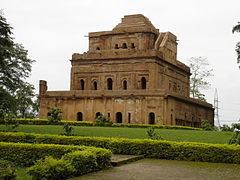Location SivasagarAssamIndia | Construction started 1751 | |
 | ||
Architectural style Ahom Kingdom Architecture Structural system Bricks and Indigenous type of cement Similar | ||
Kareng Ghar (Pron:/ˌkɑ:ɹɛŋ ˈgɑ:/, Assamese: কাৰেং ঘৰ; meaning "royal palace"), also known as The Garhgaon Palace, is located in Garhgaon, 15 kilometres (9.3 mi) from present-day Sivasagar, in Upper Assam, India. Of all Ahom ruins, the Kareng Ghar is one of the grandest examples of Ahom architecture. The palace structures were made of wood and stones. In 1747 Pramatta Singha, son of Rudra Singha, constructed the brick wall of about 5 kilometres (3.1 mi) in length surrounding the Gargaon Palace and the masonry gate leading to it.
Contents
- Map of Kareng Ghar Gangori Bazaar JDA Market Kanwar Nagar Jaipur Rajasthan 302007
- Talatal kareng ghar of ahom era sibsagar assam travel
- Kareng Ghar
- Rangpur Palace
- Talatal Ghar
- References
Map of Kareng Ghar, Gangori Bazaar, J.D.A. Market, Kanwar Nagar, Jaipur, Rajasthan 302007
After the destruction of the old palace it was rebuilt around 1752 as the present seven-storied structure by Rajeswar Singha (Suremphaa, 1751-1769).
The earliest constructions were commissioned by Swargadeo Rudra Singha in AD 1698. Rangpur was the capital of the Ahom Kingdom and served as its military-station.
Talatal kareng ghar of ahom era sibsagar assam travel
Kareng Ghar
After Swargadeo Rudra Singha's death the Kareng Ghar, which together with the below-ground Talatal Ghar constitutes the "Rangpur Palace", went through many architectural alterations to its structure, which resulted in its irregular shape.
Rangpur Palace
The Rangpur Palace is a seven-storied structure, four above ground (the Kareng Ghar) and the remaining three below (the Talatal Ghar). This palace was completed by Swargadeo Rajeswar Singha and his successors, during AD 1751-1769.
Kareng Ghar
From east to west, several rooms run along a long corridor; and from north to south are smaller wings. The ground floor served as stables, store rooms, and servants' quarters. The Kareng Ghar was built mainly of wood, which was largely destroyed over time. The royal apartments were on the upper storey, of which only a few rooms now remain, close to an octagonal room on the northern wing which once served as the Puja Ghar (prayer house). There are stairs leading up to the terrace. An isolated room stands on the south which is believed to have been used by the queen during her confinement.
Talatal Ghar
Swargadeo Rajeswar Singha added the three floors below ground, which from the Talatal Ghar. This is made of brick and an indigenous type of cement (a mixture of Bora Chaul: a sticky variety of rice grain, eggs of hens, etc.). The Talatal Ghar had two secret underground tunnels. One, about 3 kilometres in length, connected the Talatal Ghar to the Dikhow River, while the other, 16 kilometres long, led to the Garhgaon Palace, and was used as an escape route in case of an enemy attack.
Visitors can only view the ground floor, the first floor, and what remains of the second and third floors of the Kareng Ghar. The floors of the Talatal Ghar below ground have been sealed off, and most of the wooden parts of the palace have disappeared over time.
The Rangpur Palace was once surrounded by a brick fortification and an earthen fort (Garh) with dikes filled with water. There is a Khar Ghar (gunpowder and ammunition store) near the palace.
